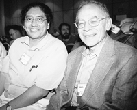Long-time IMA Head Is Founding Director of New NSF Institute in the Math Biosciences
October 7, 2002

Comparing notes in Philadelphia, at the SIAM 50th Anniversary Meeting: Carlos Castillo-Chavez, director of Cornell University's long-running summer undergraduate research program in mathematical biology, and Avner Friedman, director of the new Mathematical Biosciences Institute at Ohio State University.
In 1997, stepping down after ten years as director of the Institute for Mathematics and its Applications at the University of Minnesota, Avner Friedman "was looking for something new." During the SIAM 50th Anniversary Meeting in Philadelphia this summer, he told SIAM News about a few of the ideas he had found particularly exciting.
People have been modeling the growth of tumors, he said, including nutrients, cells that die, cells that are quiescent, and cells that proliferate. The models don't get to the molecular level, though, and researchers are now trying to build bridges from their models at the cellular level to the molecular level. At that point, the models could be used, say, to assess the effects of different chemotherapy regimens.
Given the obvious potential payoffs of the research, along with Friedman's long-standing interest in free boundary problems and his involvement in several IMA activities in biomathematics, models of tumor growth seemed to be a natural direction.
And, indeed, they are part of the exciting new direction Friedman has chosen. It wasn't until 2000, he said, when the National Science Foundation invited the community to submit proposals for new institutes in the mathematical sciences---to be supported at the level of the IMA, the Mathematical Sciences Research Institute in Berkeley, and the Institute for Pure and Applied Mathematics at UCLA---that he found what he was looking for. "I knew immediately that this was what I wanted to do," he said.
Drawing on his experience at the IMA (and at the Minnesota Center for Industrial Mathematics---MCIM, also at the University of Minnesota, which he directed from 1994 to 2001), Friedman began to envision a new institute. He had the focus---biomathematics---and he thought that a large state university would be the ideal home. At Ohio State University he found several advantages, including a well-funded medical school and strong support from the president (William Kirwan---since relocated to Maryland) and from the mathematics and statistics departments.
Much work and seven trips to Ohio later, the proposal was ready. And this summer, shortly before the SIAM meeting, Philippe Tondeur, then director of NSF's Division of Mathematical Sciences, made the announcement: Three new institutes would be funded, including the Mathematical Biosciences Institute at Ohio State University, with Friedman as the first director.*
As pointed out on its Web site (http://mbi.osu.edu/), MBI was created to develop mathematical theories, statistical methods, and computational algorithms for the solution of fundamental problems in the biosciences. The institute will create opportunities for mathematical scientists and bioscientists to work together toward the solution of such problems. An important part of the institute's mission is to increase the population of people who are able to work on these problems.
As described in the accompanying article, the program for the first year is in mathematical neuroscience. In the second year, the emphasis will shift to mathematical modeling of cell processes (intra- and intercellular, as well as long-distance, communication among the human body's 1014 cells). Participants in the third year's program, in genomics, will be picking up some of the work of the current neuroscience program, Friedman said.
Some OSU people will be involved in MBI, including faculty in the mathematical sciences and statistics, and in the biosciences. The institute will also have short- and long-term visitors. As at the IMA, postdocs will play an important role at MBI. Friedman expects an eventual total of at least 12 postdocs, each of whom will have two mentors, one in mathematics and the other in biology. He anticipates that it will take a postdoc about three years to come up to speed in the two fields.
Friedman is enthusiastic about the format for MBI's summer programs, scheduled to begin in the summer of 2003. The 40 participants will include 10 undergraduate and 10 graduate students, 10 professors, and 10 high school teachers. Participants will spend much of their time working on individual projects developed from themes that emerged during the activities of the previous year (the theme for next summer is "Neuronal Rhythms"). The hope, Friedman explained, is that the high school teachers (who will have to come in pairs, one in biology, one in mathematics, from the same school) will develop new materials and modules for use in their classrooms, and that participating professors will enrich their teaching, presenting, say, ODEs in the context of problems arising in neuroscience.
Funding for MBI is $10 million, $2 million a year for five years. Friedman pointed out that the center will also raise money from outside, some (he hopes) from the National Institutes of Health and some from another resource that he has come to know quite well: industry.
MBI will hold an inaugural dinner on October 11, during its first workshop, on neuronal dynamics (see accompanying article or the MBI Web site for further information). The keynote speaker will be NSF director Rita Colwell.
Back at the University of Minnesota, meanwhile, plans are under way for another special meeting: The School of Mathematics is organizing a conference, Current Trends in Mathematics and its Applications, to be held November 8-10, in honor of Friedman on his 70th birthday (www.math.umn.edu/arb/friedman/).
*The two other new institutes are the Statistical and Applied Mathematical Sciences Institute (SAMSI), a partnership of four institutions (Duke University, North Carolina State University, the National Institute of Statistical Sciences, and the University of North Carolina), and the American Institute of Mathematics (AIM) Research Conference Center, in Palo Alto.

